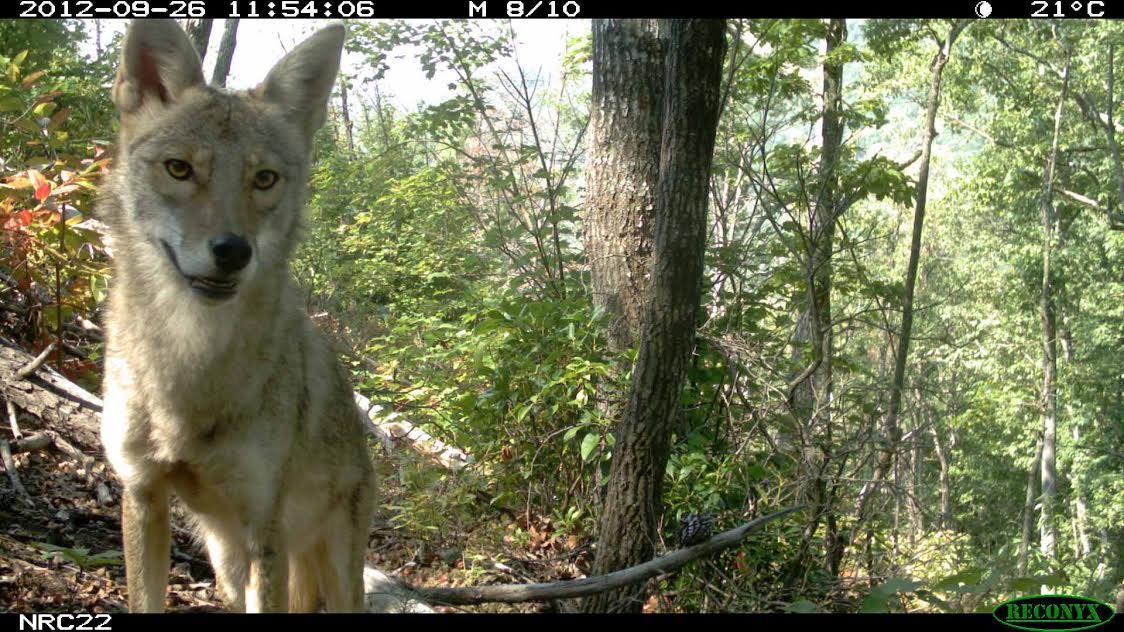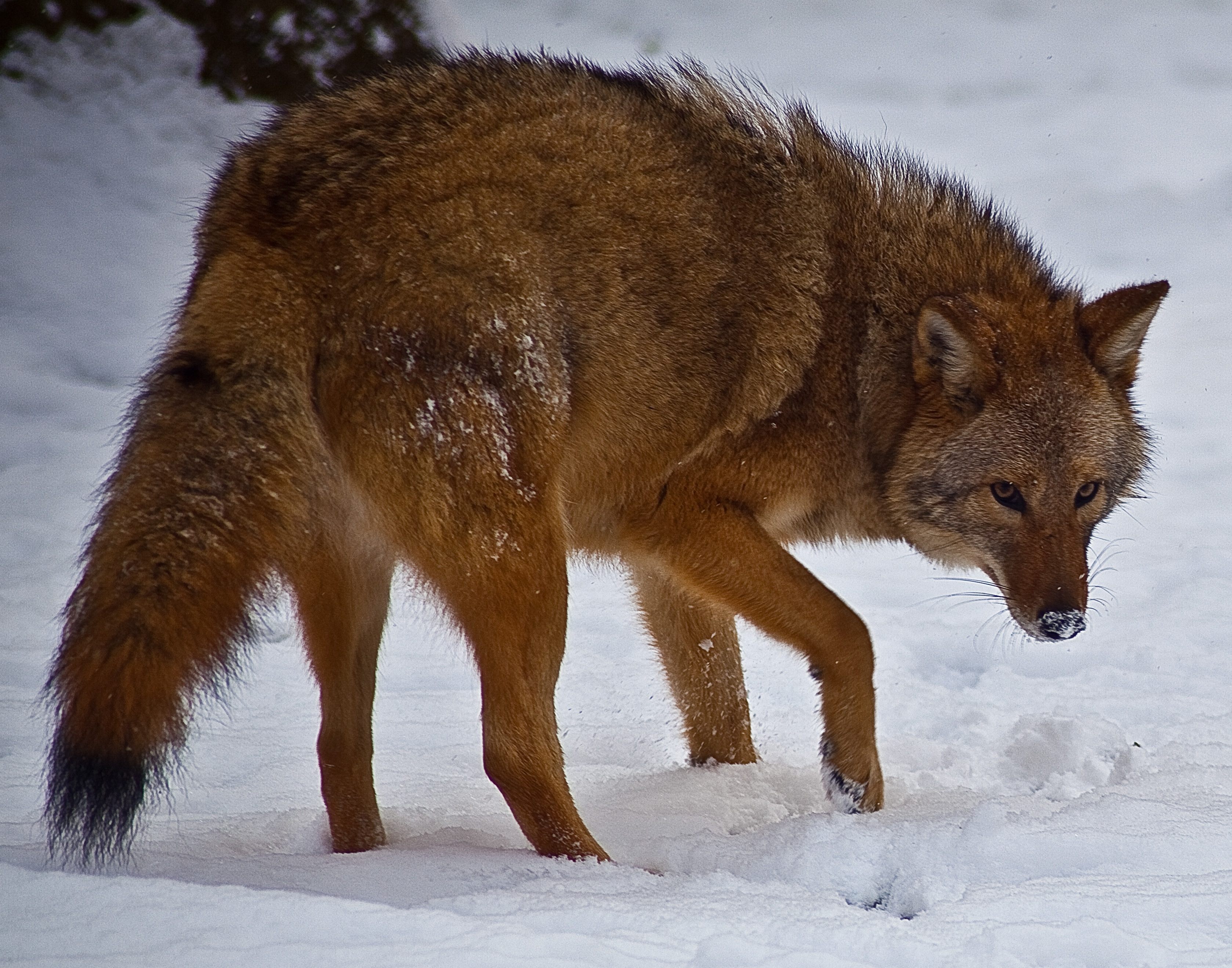A New Wolf-Coyote Hybrid is Infiltrating Our Cities

Wild canine hybrids lurk in our midst. (Photo: WikiCommons/Public Domain)
Have you heard any wolves howling in the northeast recently? Most likely not, since there aren’t any of them left. But if you heard one 150 years ago, this is probably the English translation of her cries: “I have literally no dating options left in my species … Any wolves out there? Anyone!”
Nope.
Wolves in eastern North America, whose populations steadily dwindled due to deforestation and hunting, had no choice but to settle for coyotes. Interspecies dating is a wonderful thing, but for a wolf, the larger and handsomer of the two canines, a coyote is still a serious downgrade, even if some dog genes are thrown into the mix (lonely wolves have also been known to flirt with local dogs). The result of their circumstantial romance is a mesopredator weighing in at about 55 pounds (twice the weight of coyotes), with a genetic makeup around 8 percent dog, 8 percent wolf, and 88 percent coyote. Their hybrid offspring–known as eastern coyotes, coywolves, or coywolfdogs if you want to be comprehensive–are multiplying, and neighborhoods across the northeast are starting to notice.
In New York City alone, just within the past year, eastern coyotes have been spotted in Chelsea, Long Island City, Queens, the Upper West Side, and the Bronx. They’ve taken to being nocturnal, and they can work their way through neighborhoods without causing trouble or even being noticed, a secret to their success. “They’re so, so sneaky that most people don’t ever see them,” says Dr. Roland Kays of North Carolina State University. In fact, the creature’s presence has become so commonplace that the NYC Department of Parks and Recreation has a guide called “Living With Coyotes in New York City,” which includes “Five Easy Tips for Coexisting with Coyotes.”
 Hey there, coywolfdog. (Photo: Dr. Roland Kays)
Hey there, coywolfdog. (Photo: Dr. Roland Kays)
Dr. Bradley White at Trent University says that researchers believe the coywolf originated about a century ago in Ontario, Canada. Since then, coywolves have reoccupied the original territories of the eastern wolf and have even migrated on ice floes from Nova Scotia to Newfoundland, where they’ve developed a liking for moose and caribou. Meanwhile, the carnivores have infiltrated towns and cities along the eastern seaboard, and in areas where they can hunt in packs for larger prey like deer, they’re growing larger and stronger. The coywolves found in cities like Toronto, where they prey on dogs, cats, or rodents, are still smaller, explains White.
Some scientists say that the eastern coyote may be the most adaptable animal on the planet. “It’s not only persisting but thriving,” says Kays.
Since its inception, the eastern coyote has established itself as a new top predator where wolves once reigned. They are heftier, faster, and have larger jaws than coyotes, and their songs are a blend of wolf howl and coyote yip. They eat discarded food, including fruits and vegetables, as well as available mammals. They’re opportunistic predators, meaning that they’ll take whatever they can get, another quality that makes them supremely adaptable to new environments. They’re smart, traveling by railroad track and looking both ways before crossing the highway. Rarely have we seen such a successful hybrid colonize such a large area.

A group of coywolves bred in captivity. (Photo: L. David Mech, Bruce W. Christensen, Cheryl S. Asa , Margaret Callahan, Julie K. Young/WikiCommons CC BY-SA 3.0)
The coywolfdog has taken an interesting evolutionary short cut. “Hybridization seems to be a way that evolution can work very rapidly compared to what we traditionally think,” says Kays. As natural climates and habitats change at a rate faster than ever before, hybridization is a way for different species to keep up and adapt in order to survive. Kays points out that in the fish and plant worlds, hybridization is much easier, since there’s no internal fertilization; organisms can throw their sex gametes into the wind or water and mix much more easily.
In general, though, hybridization—which, to clarify, is not a new phenomenon—is almost certainly going to grow more and more common as species’ shrinking numbers make the single-and-looking-to-mingle more and more desperate.
Hybridization is a big concern in some areas, where atypical romantic choices can cause the original form of an animal to be lost, especially between wild and domestic species. For example, the Scottish wildcat is growing rarer as it increasingly hybridizes with domestic cats; a similar thing is happening with the Asian water buffalo and its domestic counterpart, as well as woodland and migratory caribou and southern and northern flying squirrels, whose habitats have newly overlapped.

Siblings or dating? (Photo: Nickton/WikiCommons CC BY 2.0)
It also brings up a contested scientific question: what exactly qualifies as a species?
There are over 20 different species concepts, explains White, and it depends on your definition. Kays doesn’t like that the eastern coyote is being called a “coywolf” and labeled a new species–it’s not, he says. It would have to be substantially different from western coyotes and not share significant gene flow, which is the movement of individuals and their genetic material between populations. Neither of those are currently the case. “Is it evolving towards a new species, and going to be something totally different in 5,000 years? Maybe,” says Kays. But it’s not there yet.
White says that while the eastern coyote is not isolated in terms of gene flow, there’s no question that it is an entity, whether you want to call it a species or not—and whether you do comes down to whether you’re a splitter or a clumper. Do you want one group with a lot of diversity, or do you want to split it up into several different groups?

A coywolf looking coy. (Photo: www.ForestWander.com/WikiCommons CC BY-SA 3.0)
So what does the near future look like for the eastern coyote? Or, perhaps a more relevant question: what does it look like for city-dwellers from Chicago to Boston, D.C. to New York, anxious about wild canines wandering their streets at night?
“Coyotes are going to enforce the suggestion that birdwatchers have been asking for ages–to keep cats indoors,” says Kays. “That’s really the biggest concern.” In some western areas, he says, coyotes have gotten bold, but that hasn’t happened yet on the east coast. He explains that coyotes are naturally keen to avoid dangerous creatures, having had to watch out for bigger predators like wolves and cougars.
“If they realize that humans are dangerous creatures, they will avoid us and reduce conflict,” says Kays. “If not, they will move closer and closer, eat cats, dogs, and could potentially even start attacking small people.” It’s important to make sure they maintain a healthy fear of humans, and that city-dwellers not begin feeding them. Other than that, “turns out there’s not much we can actually do about it,” says Kays.
The only thing that can really reduce the number of coyotes in an area is adding wolves to keep them out. But that won’t work. We’ve run out of wolves, and the ones that remain have already starting shacking up with coyotes.
“I think the coyotes are here to stay,” says White. “Now it’s a matter of humans learning to adapt.”


















Follow us on Twitter to get the latest on the world's hidden wonders.
Like us on Facebook to get the latest on the world's hidden wonders.
Follow us on Twitter Like us on Facebook